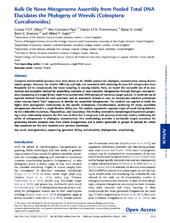| dc.contributor.author | Gillett, Conrad P.D.T. | eng |
| dc.contributor.author | Crampton-Platt, Alex | eng |
| dc.contributor.author | Timmermans, Martin J.T.N. | eng |
| dc.contributor.author | Jordal, Bjarte Henry | eng |
| dc.contributor.author | Emerson, Brent C. | eng |
| dc.contributor.author | Vogler, Alfried P. | eng |
| dc.date.accessioned | 2015-09-22T12:13:26Z | |
| dc.date.available | 2015-09-22T12:13:26Z | |
| dc.date.issued | 2014 | |
| dc.identifier.issn | 1537-1719 | |
| dc.identifier.issn | 0737-4038 | |
| dc.identifier.uri | https://hdl.handle.net/1956/10497 | |
| dc.description.abstract | Complete mitochondrial genomes have been shown to be reliable markers for phylogeny reconstruction among diverse animal groups. However, the relative difficulty and high cost associated with obtaining de novo full mitogenomes have frequently led to conspicuously low taxon sampling in ensuing studies. Here, we report the successful use of an economical and accessible method for assembling complete or near-complete mitogenomes through shot-gun next-generation sequencing of a single library made from pooled total DNA extracts of numerous target species. To avoid the use of separate indexed libraries for each specimen, and an associated increase in cost, we incorporate standard polymerase chain reaction-based “bait” sequences to identify the assembled mitogenomes. The method was applied to study the higher level phylogenetic relationships in the weevils (Coleoptera: Curculionoidea), producing 92 newly assembled mitogenomes obtained in a single Illumina MiSeq run. The analysis supported a separate origin of wood-boring behavior by the subfamilies Scolytinae, Platypodinae, and Cossoninae. This finding contradicts morphological hypotheses proposing a close relationship between the first two of these but is congruent with previous molecular studies, reinforcing the utility of mitogenomes in phylogeny reconstruction. Our methodology provides a technically simple procedure for generating densely sampled trees from whole mitogenomes and is widely applicable to groups of animals for which bait sequences are the only required prior genome knowledge. | en_US |
| dc.language.iso | eng | eng |
| dc.publisher | Oxford University Press | eng |
| dc.rights | Attribution CC BY | eng |
| dc.rights.uri | http://creativecommons.org/licenses/by/3.0/ | eng |
| dc.subject | next-generation sequencing | eng |
| dc.subject | genomics | eng |
| dc.subject | MiSeq | eng |
| dc.subject | mitochondria | eng |
| dc.subject | phylogenetics | eng |
| dc.subject | wood-boring | eng |
| dc.title | Bulk de novo mitogenome assembly from pooled total DNA elucidates the phylogeny of weevils (Coleoptera: Curculionoidea) | eng |
| dc.type | Peer reviewed | en_US |
| dc.type | Journal article | en_US |
| dc.date.updated | 2015-07-29T12:59:05Z | |
| dc.description.version | publishedVersion | |
| dc.rights.holder | Copyright 2014 The Authors | eng |
| dc.identifier.doi | https://doi.org/10.1093/molbev/msu154 | |
| dc.identifier.cristin | 1150951 | |
| dc.source.journal | Molecular biology and evolution | |
| dc.source.40 | 31 | |
| dc.source.14 | 8 | |
| dc.source.pagenumber | 2223-2237 | |
| dc.relation.project | Norges forskningsråd: 214232 | |
| dc.subject.nsi | VDP::Matematikk og naturvitenskap: 400::Basale biofag: 470::Genetikk og genomikk: 474 | |
| dc.subject.nsi | VDP::Mathematics and natural scienses: 400::Basic biosciences: 470::Genetics and genomics: 474 | |

